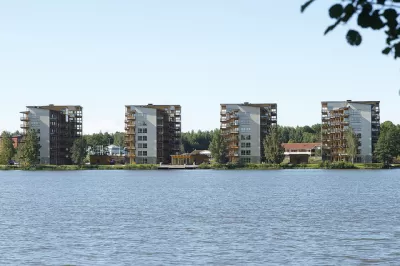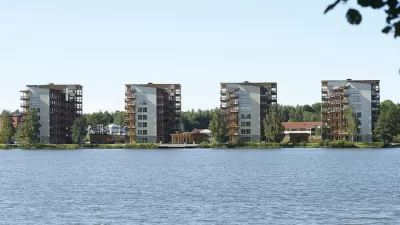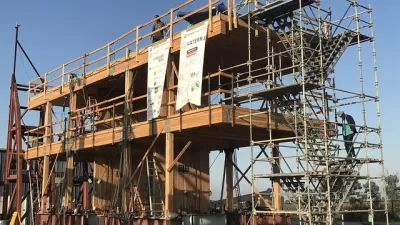Mass timber is a major structural element of an increasing number of skyscrapers, according to a CTBUH survey; now, the fire codes just have to follow.

At The Architect’s Newspaper, Matthew Messing interviews Daniel Safarik, editor of the Council on Tall Buildings and Urban Habitats (CTBUH) about its recently released global audit of “tall timber” buildings.
Tall timber refers to the use of mass timber to construct buildings that are more than seven stories; the audit follows “a spike in announcements of timber tall buildings being proposed and constructed about four years ago [2013].”
Mass timber is an “umbrella term” for several new materials (like cross-laminated timber) that make it possible to use wood to construct skyscrapers.
For reasons ranging from its potential for carbon sequestration to the possibility of local production, timber has been described as “a new frontier in low-carbon building.”
The main obstacle facing the use of tall timber is fire, both in the sense of codes it may not meet and in the sense of fears it may inspire.
The fears, Safarik says, don’t take into account the fact that these materials are produced with fire prevention in mind.
“The key to mass timber’s viability as a structural material for tall buildings lies in its name. Massive wood walls and structural beams and columns comprised of engineered panels have demonstrated fire performance equal to concrete and, in some cases, superior to steel.”
And while the “foremost obstacle” to tall timber construction is local fire codes, Safarik is confident that “[a]s more jurisdictions come to appreciate the aesthetic, economic, and environmental advantages of tall timber, fire codes are expected to change.”
The CTBUH audit lists nearly 50 tall timber designs, ranging in height from seven to 35 stories, and in geography from Lagos to Vienna to Minneapolis.
FULL STORY: Learning from the 2017 global timber tower audit

Study: Maui’s Plan to Convert Vacation Rentals to Long-Term Housing Could Cause Nearly $1 Billion Economic Loss
The plan would reduce visitor accommodation by 25,% resulting in 1,900 jobs lost.

North Texas Transit Leaders Tout Benefits of TOD for Growing Region
At a summit focused on transit-oriented development, policymakers discussed how North Texas’ expanded light rail system can serve as a tool for economic growth.

Why Should We Subsidize Public Transportation?
Many public transit agencies face financial stress due to rising costs, declining fare revenue, and declining subsidies. Transit advocates must provide a strong business case for increasing public transit funding.

How to Make US Trains Faster
Changes to boarding platforms and a switch to electric trains could improve U.S. passenger rail service without the added cost of high-speed rail.

Columbia’s Revitalized ‘Loop’ Is a Hub for Local Entrepreneurs
A focus on small businesses is helping a commercial corridor in Columbia, Missouri thrive.

Invasive Insect Threatens Minnesota’s Ash Forests
The Emerald Ash Borer is a rapidly spreading invasive pest threatening Minnesota’s ash trees, and homeowners are encouraged to plant diverse replacement species, avoid moving ash firewood, and monitor for signs of infestation.
Urban Design for Planners 1: Software Tools
This six-course series explores essential urban design concepts using open source software and equips planners with the tools they need to participate fully in the urban design process.
Planning for Universal Design
Learn the tools for implementing Universal Design in planning regulations.
City of Santa Clarita
Ascent Environmental
Institute for Housing and Urban Development Studies (IHS)
City of Grandview
Harvard GSD Executive Education
Toledo-Lucas County Plan Commissions
Salt Lake City
NYU Wagner Graduate School of Public Service





























